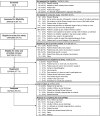Exploring the role of pain as an early predictor of category 2 pressure ulcers: a prospective cohort study
- PMID: 28110286
- PMCID: PMC5253581
- DOI: 10.1136/bmjopen-2016-013623
Exploring the role of pain as an early predictor of category 2 pressure ulcers: a prospective cohort study
Abstract
Objective: To explore pressure area related pain as a predictor of category ≥2 pressure ulcer (PU) development.
Design: Multicentre prospective cohort study.
Setting: UK hospital and community settings.
Participants inclusion: Consenting acutely ill patients aged ≥18 years, defined as high risk (Braden bedfast/chairfast AND completely immobile/very limited mobility; pressure area related pain or; category 1 PU).
Exclusion: Patients too unwell, unable to report pain, 2 or more category ≥2 PUs.
Follow-up: Twice weekly for 30 days.
Primary and secondary outcome measures: Development and time to development of one or more category ≥2 PUs.
Results: Of 3819 screened, 1266 were eligible, 634 patients were recruited, 32 lost to follow-up, providing a 602 analysis population. 152 (25.2%) developed one or more category ≥2 PUs. 464 (77.1%) patients reported pressure area related pain on a healthy, altered or category 1 skin site of whom 130 (28.0%) developed a category ≥2 PU compared with 22 (15.9%) of those without pain. Full stepwise variable selection was used throughout the analyses. (1) Multivariable logistic regression model to assess 9 a priori factors: presence of category 1 PU (OR=3.25, 95% CI (2.17 to 4.86), p<0.0001), alterations to intact skin (OR=1.98, 95% CI (1.30 to 3.00), p=0.0014), pressure area related pain (OR=1.56, 95% CI (0.93 to 2.63), p=0.0931). (2) Multivariable logistic regression model to account for overdispersion: presence of category 1 PU (OR=3.20, 95% CI (2.11 to 4.85), p<0.0001), alterations to intact skin (OR=1.90, 95% CI (1.24 to 2.91), p=0.0032), pressure area related pain (OR=1.85, 95% CI (1.07 to 3.20), p=0.0271), pre-existing category 2 PU (OR=2.09, 95% CI (1.35 to 3.23), p=0.0009), presence of chronic wound (OR=1.66, 95% CI (1.06 to 2.62), p=0.0277), Braden activity (p=0.0476). (3) Accelerated failure time model: presence of category 1 PU (AF=2.32, 95% CI (1.73 to 3.12), p<0.0001), pressure area related pain (AF=2.28, 95% CI (1.59 to 3.27), p<0.0001). (4) 2-level random-intercept logistic regression model: skin status which comprised 2 levels (versus healthy skin); alterations to intact skin (OR=4.65, 95% CI (3.01 to 7.18), p<0.0001), presence of category 1 PU (OR=17.30, 95% CI (11.09 to 27.00), p<0.0001) and pressure area related pain (OR=2.25, 95% CI (1.53 to 3.29), p<0.0001).
Conclusions: This is the first study to assess pain as a predictor of category ≥2 PU development. In all 4 models, pain emerged as a risk factor associated with an increased probability of category ≥2 PU development.
Keywords: Cohort; Multi-level; Observational; Pain; Pressure Ulcers; Risk factors.
Published by the BMJ Publishing Group Limited. For permission to use (where not already granted under a licence) please go to http://www.bmj.com/company/products-services/rights-and-licensing/.
Conflict of interest statement
Competing interests: JN, EAN, SC and JB have received grant funding from the Worldwide Universities Network Leeds Fund for International Research Collaborations; DM has received consultancy funding from Smith & Nephew on behalf of the Pressure Ulcer Research Service User Network for the UK (PURSUN UK) for patient and public involvement input into educational materials and JN and CD have received grant funding from Mölnlycke Healthcare. CD was a member of an expert advisory board which advises Mölnlycke on the use of dressings for pressure ulcer prevention.
Figures


References
-
- Girouard K, Harrison MB, VanDenKerkof E. The symptom of pain with pressure ulcers: a review of the literature. Ostomy Wound Manage 2008;54:30–40, 42. - PubMed
-
- Pieper B, Langemo D, Cuddigan J. Pressure ulcer pain: a systematic literature review and national pressure ulcer advisory panel White paper. Ostomy Wound Manage 2009;55:16–31. - PubMed
Publication types
MeSH terms
Grants and funding
LinkOut - more resources
Full Text Sources
Other Literature Sources
Medical
